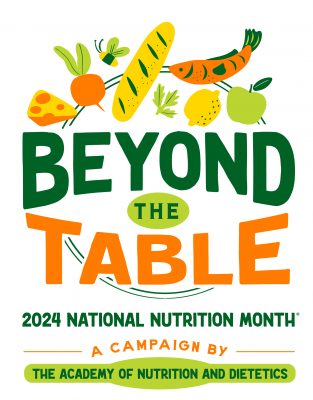Food, Nutrition and Health Tips from the Academy of Nutrition and Dietetics

This year’s theme for National Nutrition Month® inspires us to look Beyond the Table when thinking about our health and the environment. Choices we make daily, including what we’re going to eat and drink, can make a big difference — both now and in the future.
School and family meals are important, but healthy choices go beyond the foods and drinks we enjoy while sitting at the lunch or dinner table. They include our snacks, breakfasts on the go, eating out with friends, and even where foods are grown and how they’re prepared. Our food choices also can affect the health of our planet. Have you ever thought about the work that goes into producing the foods we eat? This includes how food is grown or raised, where and how it is made, as well as its safety. It’s important to think about the foods we eat and the nutrition they provide, but is there more we could be doing to improve our health and the environment?
Focus on a healthy eating routine
Making healthy food choices may seem difficult at times, especially when eating away from home, but it doesn’t have to be. Many eating places provide nutrition information right on the menu or online to help you choose healthier options. When purchasing food from a store, use a grocery list and pay attention to sales. You also can learn about resources in your community that offer access to healthy foods, such as food banks.
These are a few tips to help you reach Beyond the Table:
Seek the help of a Registered Dietitian Nutritionist (RDN)
Registered dietitian nutritionists, also known as RDNs, are food and nutrition experts who help people live healthier lives. RDNs can help you explore ways Beyond the Table to reach your health goals. Make an appointment with an RDN who specializes in your specific needs to jumpstart your plan for personal wellness.
Learn what’s involved in growing your food
There are many ways you can learn about how your food is produced. Visit a local farm or farmers market and talk with the people who are growing and harvesting your food. Many farmers and food producers will be happy to answer your questions, let you sample products or provide recipes for foods that are new to you. Some local farms even have tours, so people can see how they operate. You also can grow your own fruits and vegetables at home. Want to try gardening but have limited space? Grow herbs or lettuce indoors. Tomatoes, peppers, or strawberries may work, too, if you have a patio or porch with enough sunlight. Schools, churches, and other places may offer community gardens where you can participate in the growing process and share in the harvest. Not quite ready to get your hands in the dirt? Many local farms offer programs, which include “farm shares” of produce during a growing season. Depending on the farm, additional products such as eggs or meat might be included.
Supporting farmers by buying locally grown and seasonal foods can help you eat with the environment in mind. Other steps include decreasing food waste at home by creating new dishes from leftovers or by composting. You also can add more plant-based foods to your meals and snacks. National Nutrition Month is a great time to start thinking about how you can go Beyond the Table to improve both your health and the planet’s.
This material is funded by USDA’s Supplemental Nutrition Assistance Program.
This institution is an equal opportunity provider.